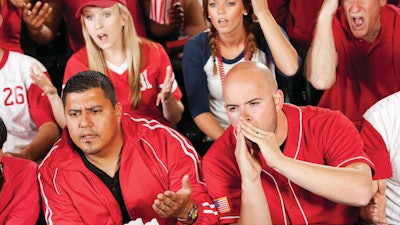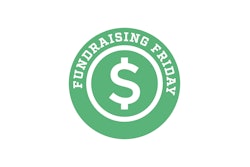
Professional athletes can expect some razzing when playing on the road, especially when visiting a rival or the player’s former home team. Often, it can be ignored. On some occasions, it can’t.
Former Boston Celtics guard Marcus Smart returned to TD Garden on April 6, this time as a member of the Washington Wizards, and was heckled on the visiting team bench to the extent he felt it necessary to point out a fan to arena security for ejection.
“He just crossed the line. We all know, I don’t do line-crossing,” Smart said in the locker room afterward. “You never want to see that, especially for a guy who’s coming back and has given the city everything he has.”
As for his role in identifying the heckler, Smart added, “Just trying to get him out before it escalated more than what it was.”
Fans at all levels of sport have been doing a lot of line-crossing lately. The TD Garden confrontation represented the 24th episode involving spectator behavior — from seemingly innocuous court-stormings to a fatal stabbing — tracked by AB this year.
“That’s a lot,” says Murray State University professor Dan Wann, who has been studying fan behavior for decades. “And whatever the number is, it’s an underestimate, because so much of this stuff goes unreported.”
Clearly, Wann and others who are watching the watchers see a trend heading in the wrong direction. “The eye test suggests that fans are getting more unruly by the year,” Wann says. “We know that society is becoming less civil. We know that over the generations, empathy has gone down. And if those things are true, there’s no reason to expect that fans are any different.”
As the quantity of headline-grabbing incidents appears to increase, the search for quality solutions soldiers on in earnest.
 Photo by Justin Shen, Unsplash
Photo by Justin Shen, Unsplash
‘Proactive Game Management’
Smart instinctively sensed it was time to bring his heated back-and-forth with a Boston fan to an end, but ejection is often seen as a last resort, particularly at the amateur sport level.
Having spent more than 20 years as a high school athletics administrator and the past 15 training schools and state associations in security techniques through his Safe Sport Zone LLC, Jay Hammes says he’s never seen worse fan behavior than what he’s witnessing today.
“It really is all about people wanting immediate gratification,” Hammes says. “Today, if they don’t get it, they act out of control — starting with frustration, which leads to anger, which leads to verbal altercations, which leads to physical altercations, and sometimes weapons use. But it all starts with frustration, and that time frame has certainly sped up and is much faster than it was before COVID.”
What does one do to prevent dangerous situations and defuse those in progress? Hammes’ so-called “Proactive Game Management” approach has three facets: scanning the gate, scanning the crowd and securing the venue perimeter post-event.
“People think that scanning the gate with handheld metal detectors or magnetometers proves we have a problem. And that theory has got to go,” Hammes says. “We should be training our high school public for the next level — college and pro. Everywhere you go in college and pro, they’re definitely scanning the gate. The idea is to scan that single point of entry, similar to TSA security at airports. We should be doing the same thing for our high school games.”
Scanning the crowd involves “assigning areas in the gymnasium to workers and have them scan their assigned area every few minutes. Why? Because if you’re scanning that area religiously every few minutes, you can identify anger issues — loud, obnoxious voices and negative, unsportsmanlike behavior,” says Hammes. “If you watch them — just watch them — that sometimes de-escalates them, because they know you’re watching.”
According to Hammes, one volunteer should be able to scan a section of 250 fans. If merely making eye contact with a potential culprit fails to curb their behavior, the volunteer may have to move closer to the spectator. “They’re in the 18th row, go up there in the 19th row, so you’re close to them,” he says. “That helps to de-escalate them.”
If non-verbal headshakes fall short of communicating that the behavior is unacceptable, a dialog should begin. “There’s a right way and a wrong way to address these fans,” Hammes says. “The first thing you have to do when talking to an irate fan is keep all dialogue in question format. Go up there and say, ‘I’m sorry, sir. Can I help you?’ in a calming, respectful way to try to get this person to respond, and when they respond, schools need to listen instead of interrupting. That’s the de-escalation process. It makes so much sense, and it works, but schools aren’t doing it.”
The final facet of the Hammes model is a perimeter security plan. “A majority of all our problems happen after the game, and they’re outside the venue in the parking lots and walkways,” he says. “The game’s not over until the last car leaves the parking lot. We have to zone in and have a plan for perimeter security. I had volunteers who said, ‘I’d do everything, but I don’t want to go outside in that parking lot after the game.’ I can understand that. You have to have some people who are mentally ready to work with law enforcement to secure that area outside the venue.”
 Photo by Wade Austin, Unsplash
Photo by Wade Austin, Unsplash
De-escalation in detail
Susan Driscoll is president of Crisis Prevention Institute, which offers training in de-escalation techniques to a variety of clients — from retail stores to emergency rooms. CPI also works with security teams assigned to Super Bowl games, but the institute’s lone formal sports-related partnership is with Hammes’ Safe Sport Zone.
“Our training is all about how to recognize the warning signs and how to de-escalate early so that a situation doesn’t get to what we call ‘risk behavior,’ ” Driscoll says. “We have a 30-minute online training that presents the basics of de-escalation, and then we have higher levels of training to the point where we teach physical intervention. If somebody is violent, how do you physically manage their behavior to keep them safe and to keep everybody else safe? That’s the highest level of training.”
Driscoll identifies four states of a crisis. “The first is anxiety,” she says. “You can tell that somebody is agitated. They’re not yelling or screaming yet, but they might be pacing. They might be tapping their foot. You can tell by the look on their face. Body language cues are super important. At that stage, the response is to be supportive — recognize their feelings. ‘You seem to be upset. Anything I can do to help you?’ ”
The second stage is what CPI refers to as the defensive stage. “That’s where they’ll challenge you. They might refuse to do what you ask them to do,” Driscoll says. “At that point we teach, again, to stay very calm, to recognize their feelings, but the most important thing is to not get involved in a power struggle — to recognize that they are challenging you, but to diffuse that challenge.
“The third stage is risk behavior, and that’s where they might push or shove. At that point, most volunteers would ask for help from a person trained in how to disengage a person or to move them out of the way before they get physically violent.”
The final stage is what Driscoll describes as a post-incident release. “There’s a release after the incident, and so it’s important to re-engage with that person, recognize their feelings and try to re-establish the relationship.”
“The basics of de-escalation are simple but very powerful,” she says, “and once we teach it, people really know how to apply it.”
There are two additional dynamics that CPI addresses in its training: the integrated experience and precipitating factors. Driscoll describes the former as “the principle that my behavior can influence your behavior. If you are anxious and I stay calm, I can actually help to restore your calm. If I start to get reactive or agitated, I’m going to escalate you more.”
“We teach people rational detachment,” she says. “It’s how you stay calm and controlled and don’t get engaged in an incident, even though you may want to. You may want to challenge them, but you have to stay calm.”
This is a principal that can be incorporated into a high school sports team’s preseason parent meetings, with the idea that seeding the stands with parents who possess the ability to impact others seated around them could have a positive impact on overall crowd temperament.
Precipitating factors take into account a broader set of triggers that may be contributing to an individual’s behavior in the moment. “We teach workers to understand that it’s not what’s happening right now — it’s what else is happening in their life,” Driscoll says. “They’re worried about paying their bills. It’s everything you hear in the media. It’s all this uncertainty that is just baggage that we all carry, and we’re bringing that to wherever we go. That’s why you’re seeing more disruptions in every aspect of society.”

Power of fans, leagues
Murray State’s Wann looks no further than the advent of family sections as proof that society has changed. “If they have to actually sequester families away from the less appropriately behaving fans, that’s probably a sign,” he says. “I’ve had people say, ‘What’s the big deal? You have a crowd of 80,000 and only five of them are unruly.’ Yeah, but those five people are impacting the good time — or now, the lack thereof — of all the people around them.”
Wann applauds teams that employ a clearinghouse of anonymous text messages from fans essentially tattling on the troublemakers. “That gives the fans power,” he says. “It empowers the fans behaving appropriately to be like, ‘Okay, maybe I can do something to make this situation better. I don’t have to sit here and take it.’ ”
But that’s only half the battle. “If you have these policies in place, that is great, but if you do not enforce them, then they have absolutely no point whatsoever,” Wann adds. “If you see something going on, you send that text and you don’t see anything happening, because there’s not actually any security employed to do anything about it anyway, then that’s just going to literally give the fans the feeling of helplessness.”
Like Hammes, Wann says he would like to see all levels of sport adopt pro-model approaches to address fan behavior. “I think it should go all the way down to tee ball,” he says. “I mean, it’s one thing to see fans act up at a Major League Baseball game or an NFL game, but to watch what the parents do at these high school basketball games, it just breaks my heart. You’re not just embarrassing yourself. That’s your child out there.”
As of this writing, the full consequence for the fan ejected for engaging with Smart wasn’t clear, but the Celtics have a recent history of banning fans for years at a time. “I think you’re starting to see more conversations on, ‘Okay, how can we elevate the consequences to where people think twice about acting out at a game,’ ” says University of Southern Mississippi sports management professor Stacey Hall, who serves as executive director of the National Center for Spectator Sports Safety and Security at USM. “We’re seeing more fan codes of conduct. Maybe you start talking about banning the individual from that specific venue, or that league. And I think a lot of leagues are now starting to put measures in place where if you act out, you know there are going to be consequences — severe consequences.”
Hall points to Major League Soccer, which requests that ejected fans complete code-of-conduct training if they hope to return to any MLS venue in the future. “Same with the NFL,” she says. “You can ban somebody from one venue. You can ban them from all 32. I think that’s where the conversation is now leading — to the consequences and what’s going to happen — to try and act more as a deterrent.”
Wann agrees. “I don’t ever believe necessarily in the heavy hand, but when sports organizations say, ‘Okay, enough is enough, we’re not going to let you back in, one strike and you’re out,’ and then publicize when they successfully eliminate these people, you hope that then there’s a trickledown effect on people, like, ‘Okay, I guess I’m not supposed to do this anymore,’ ” he says. “But to think that you can do any one thing to change overnight a pattern that’s evolved over decades — no. You have to change those ‘one things,’ and hopefully that changes the whole culture.”





































